Rybinsk
Rybinsk (Russian: Рыбинск, IPA: [ˈrɨbʲɪnsk]) is the second-largest city of Yaroslavl Oblast in Russia. It lies at the confluence of the Volga and Sheksna rivers, 267 kilometres (166 mi) north-north-east of Moscow. Population: 200,771 (2010 Census);[2] 222,653 (2002 Census);[7] 251,442 (1989 Census).[8]
Rybinsk
Рыбинск | |
|---|---|
 Transfiguration Cathedral in Rybinsk | |
 Flag .png.webp) Coat of arms | |
Location of Rybinsk | |
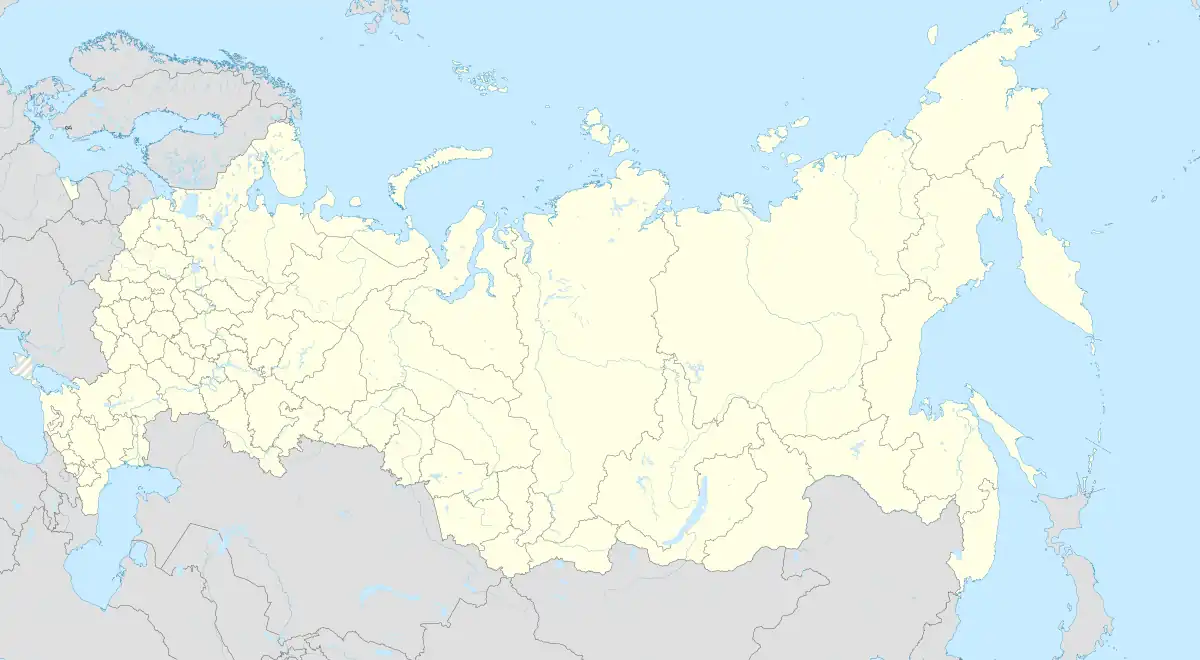 Rybinsk Location of Rybinsk 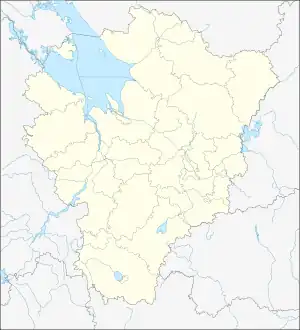 Rybinsk Rybinsk (Yaroslavl Oblast) | |
| Coordinates: 58°03′N 38°50′E | |
| Country | Russia |
| Federal subject | Yaroslavl Oblast[1] |
| First mentioned | 1071 |
| City status since | 1777 |
| Government | |
| • Mayor | Dmitry Rudakov |
| Elevation | 100 m (300 ft) |
| Population | |
| • Total | 200,771 |
| • Estimate (2018)[3] | 188,678 (−6%) |
| • Rank | 93rd in 2010 |
| • Subordinated to | city of oblast significance of Rybinsk[1] |
| • Capital of | Rybinsky District,[1] city of oblast significance of Rybinsk[1] |
| • Urban okrug | Rybinsk Urban Okrug[4] |
| • Capital of | Rybinsk Urban Okrug,[4] Rybinsky Municipal District |
| Time zone | UTC+3 (MSK |
| Postal code(s)[6] | 152900—152939 |
| Dialing code(s) | +7 4855 |
| OKTMO ID | 78715000001 |
| Website | www |
It was previously known as Ust-Sheksna (until 1504), Rybnaya Sloboda (until 1777), Shcherbakov (1946–1957), and Andropov (1984–1989).
History
Early history

Rybinsk is one of the oldest Slavic settlements on the Volga River. The place was first recorded by chroniclers in 1071 as Ust-Sheksna, i.e. "the mouth of the Sheksna". During this period the settlement was a regional center for craft and metal based produce and for trade. In the mid-13th century, Ust-Sheksna was laid waste by invading Mongols. For the next few centuries, the settlement was referred to alternatively as Ust-Sheksna or Rybansk. From 1504, it was identified in documents as Rybnaya Sloboda (literally: "the fishing village"). The name is explained by the fact that the settlement supplied the Muscovite court with choice sturgeons and sterlets. In the 17th century, when the sloboda was capitalizing on the trade of the Muscovy Company with Western Europe, it was rich enough to build several stone churches, of which only one survives to the present. More old architecture may be found in the neighborhood, including the last of Muscovite three-tented churches (in the Alexandrov Hermitage) and the Ushakov family shrine (on Epiphany Island).
Golden age
In the 18th century, the sloboda continued to thrive on the Volga trade. Catherine the Great granted Rybnaya Sloboda municipal rights and renamed it Rybinsk. It was a place where the cargo was reloaded from large Volga vessels to smaller boats capable of navigating in the shallow Mariinsk Canal system, which connects the Russian hinterland with the Baltic Sea. With the population of 7,000, the town daily accommodated up to 170,000 sailors and up to 2,000 river vessels. Consequently, the local river port became known as the "capital of barge-haulers".
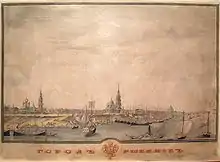
The town's most conspicuous landmark, the Neoclassical Savior-Transfiguration Cathedral, was constructed on the Volga riverside from 1838 until 1851. It was built to a design that the Dean of the Imperial Academy of Arts, Avraam Melnikov, had prepared for Saint Isaac's Cathedral in St. Petersburg. After Melnikov lost the contest for the best project of St. Isaac's Cathedral to Auguste de Montferrand, he sold his grandiose design to the municipal authorities of Rybinsk.
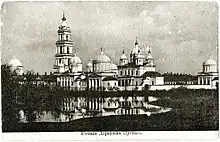
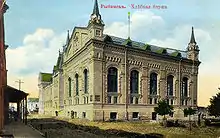
As a trade capital of the Upper Volga, Rybinsk formerly attracted scores of foreigners, who built a Lutheran church and an imposing Roman Catholic cathedral, said to be the tallest on the Volga. There is also the Nobel Family Museum, documenting the operations of that prominent Swedish family during the Russian Empire.
20th-century American film moguls Nicholas Schenck and Joseph Schenck were born in the town, and there is a grand 18th-century mansion of the Mikhalkov family, whose living members include Sergey Mikhalkov, Nikita Mikhalkov, and Andron Konchalovsky.
20th century
In the Soviet years, Rybinsk continued its impressive renaming record, for it changed its name four times: to Shcherbakov (after Aleksandr Shcherbakov) in 1946, back to Rybinsk in 1957, to Andropov (after Yuri Andropov) in 1984, and back to Rybinsk in 1989.
Administrative and municipal status
Within the framework of administrative divisions, Rybinsk serves as the administrative center of Rybinsky District, even though it is not a part of it.[1] As an administrative division, it is incorporated separately as the city of oblast significance of Rybinsk—an administrative unit with the status equal to that of the districts.[1] As a municipal division, the city of oblast significance of Rybinsk is incorporated as Rybinsk Urban Okrug.[4]
Economy
The most important industries of modern Rybinsk are NPO Saturn (two plants) AL Turborus aircraft engines, power and naval gas turbines manufacturing, RGT small plant 30 - 100 MW range gas turbines, electronics radiotronics (NPO Luch), Kalashnikov Pella Rybinsk shipyard Euroyachting, Vympel Shipyard, and a hydroelectric power station. As the experts warn, the giant Rybinsk dam which holds the Rybinsk Reservoir (formerly touted as the largest man-made body of water on Earth) places the town in the imminent danger of the dam breaking and the reservoir flooding the city. The city is served by the Staroselye Airport.
Geography
Climate
Rybinsk has a four-season humid continental climate[9] with significant differences between winters and summers, although the cold winters are still significantly less severe than those found on similar parallels further east in Russia. June, July and August all average above 20 °C (68 °F) in average high temperatures with the five months above 10 °C (50 °F) ensuring Rybinsk falls into humid continental rather than the subarctic category found further north. The yearly mean is around 4 °C (39 °F),[10] also comfortably falling within range of warm-summer humid continental climates.
| Climate data for Rybinsk | |||||||||||||
|---|---|---|---|---|---|---|---|---|---|---|---|---|---|
| Month | Jan | Feb | Mar | Apr | May | Jun | Jul | Aug | Sep | Oct | Nov | Dec | Year |
| Record high °C (°F) | 7.0 (44.6) |
6.2 (43.2) |
17.3 (63.1) |
28.0 (82.4) |
33.6 (92.5) |
33.5 (92.3) |
37.2 (99.0) |
36.0 (96.8) |
29.4 (84.9) |
24.8 (76.6) |
13.2 (55.8) |
8.9 (48.0) |
37.2 (99.0) |
| Average high °C (°F) | −5.7 (21.7) |
−5.1 (22.8) |
1.3 (34.3) |
9.6 (49.3) |
17.3 (63.1) |
21.1 (70.0) |
23.5 (74.3) |
20.8 (69.4) |
14.8 (58.6) |
7.7 (45.9) |
−0.1 (31.8) |
−4.2 (24.4) |
8.4 (47.1) |
| Daily mean °C (°F) | −10.1 (13.8) |
−9.5 (14.9) |
−4.1 (24.6) |
4.0 (39.2) |
11.0 (51.8) |
16.0 (60.8) |
18.2 (64.8) |
16.1 (61.0) |
10.4 (50.7) |
4.4 (39.9) |
−2.4 (27.7) |
−7.1 (19.2) |
3.9 (39.0) |
| Average low °C (°F) | −11.8 (10.8) |
−12.0 (10.4) |
−6.3 (20.7) |
0.6 (33.1) |
7.0 (44.6) |
11.9 (53.4) |
14.5 (58.1) |
12.3 (54.1) |
7.4 (45.3) |
2.4 (36.3) |
−4.1 (24.6) |
−9.5 (14.9) |
1.0 (33.9) |
| Record low °C (°F) | −40.1 (−40.2) |
−38.9 (−38.0) |
−34.6 (−30.3) |
−21.9 (−7.4) |
−3.1 (26.4) |
0.8 (33.4) |
5.2 (41.4) |
0.3 (32.5) |
−5.9 (21.4) |
−17.8 (0.0) |
−26.3 (−15.3) |
−42.6 (−44.7) |
−42.6 (−44.7) |
| Average precipitation mm (inches) | 46 (1.8) |
36 (1.4) |
34 (1.3) |
38 (1.5) |
51 (2.0) |
70 (2.8) |
80 (3.1) |
78 (3.1) |
64 (2.5) |
58 (2.3) |
51 (2.0) |
48 (1.9) |
654 (25.7) |
| Source: [11] | |||||||||||||
International relations
Rybinsk is twinned with:
 Kingsport, Tennessee, United States (1989)
Kingsport, Tennessee, United States (1989) Johnson City, Tennessee, United States (1989)
Johnson City, Tennessee, United States (1989) Bristol, Tennessee, United States (1989)
Bristol, Tennessee, United States (1989)
Notable people
- Aleksey Ovchinin, cosmonaut
- Genrikh Yagoda, NKVD leader
- Joseph M. Schenck
- Nicholas Schenck
- Nikita Lastochkin, racing driver
- Boris Grigoriev, artist
References
- Law #12-z
- Russian Federal State Statistics Service (2011). Всероссийская перепись населения 2010 года. Том 1 [2010 All-Russian Population Census, vol. 1]. Всероссийская перепись населения 2010 года [2010 All-Russia Population Census] (in Russian). Federal State Statistics Service.
- "26. Численность постоянного населения Российской Федерации по муниципальным образованиям на 1 января 2018 года". Federal State Statistics Service. Retrieved January 23, 2019.
- Law #65-z
- "Об исчислении времени". Официальный интернет-портал правовой информации (in Russian). June 3, 2011. Retrieved January 19, 2019.
- Почта России. Информационно-вычислительный центр ОАСУ РПО. (Russian Post). Поиск объектов почтовой связи (Postal Objects Search) (in Russian)
- Russian Federal State Statistics Service (May 21, 2004). Численность населения России, субъектов Российской Федерации в составе федеральных округов, районов, городских поселений, сельских населённых пунктов – районных центров и сельских населённых пунктов с населением 3 тысячи и более человек [Population of Russia, Its Federal Districts, Federal Subjects, Districts, Urban Localities, Rural Localities—Administrative Centers, and Rural Localities with Population of Over 3,000] (XLS). Всероссийская перепись населения 2002 года [All-Russia Population Census of 2002] (in Russian).
- Всесоюзная перепись населения 1989 г. Численность наличного населения союзных и автономных республик, автономных областей и округов, краёв, областей, районов, городских поселений и сёл-райцентров [All Union Population Census of 1989: Present Population of Union and Autonomous Republics, Autonomous Oblasts and Okrugs, Krais, Oblasts, Districts, Urban Settlements, and Villages Serving as District Administrative Centers]. Всесоюзная перепись населения 1989 года [All-Union Population Census of 1989] (in Russian). Институт демографии Национального исследовательского университета: Высшая школа экономики [Institute of Demography at the National Research University: Higher School of Economics]. 1989 – via Demoscope Weekly.
- "Rybinsk, Russia Climate Summary". Weatherbase. Retrieved January 24, 2015.
- "Rybinsk Temperature Averages". Weatherbase. Retrieved January 24, 2015.
- "Rybinsk Temperature Averages". Weatherbase. Retrieved January 24, 2015.
Sources
- Государственная Дума Ярославской области. Закон №12-з от 7 февраля 2002 г «Об административно-территориальном устройстве Ярославской области и порядке его изменения», в ред. Закона №67-з от 21 декабря 2012 г. «О внесении изменений в отдельные законодательные акты Ярославской области и признании утратившими силу отдельных законодательных актов (положений законодательных актов) Ярославской области». Вступил в силу через шесть месяцев со дня официального опубликования. Опубликован: "Губернские вести", №11, 15 февраля 2002 г. (State Duma of Yaroslavl Oblast. Law #12-z of February 7, 2002 On the Administrative-Territorial Structure of Yaroslavl Oblast and on the Procedures of Its Change, as amended by the Law #67-z of December 21, 2012 On Amending Various Legislative Acts of Yaroslavl Oblast and on Abrogation of Various Legislative Acts (Clauses of Legislative Acts) of Yaroslavl Oblast. Effective as of the day six months from the day of the official publication.).
- Государственная Дума Ярославской области. Закон №65-з от 21 декабря 2004 г. «О наименованиях, границах и статусе муниципальных образований Ярославской области», в ред. Закона №59-з от 28 декабря 2011 г «Об изменении статуса рабочего посёлка Песочное Рыбинского района и о внесении изменений в отдельные законодательные акты Ярославской области». Вступил в силу через 10 дней со дня официального опубликования. Опубликован: "Губернские вести", №70, 23 декабря 2004 г. (State Duma of Yaroslavl Oblast. Law #65-z of December 21, 2004 On the Names, Borders, and Status of the Municipal Formations of Yaroslavl Oblast, as amended by the Law #59-z of December 28, 2011 On Changing the Status of the Work Settlement of Pesochnoye of Rybinsky District and on Amending Various Legislative Acts of Yaroslavl Oblast. Effective as of after 10 days from the day of the official publication.).
External links
- Official website of Rybinsk (in Russian)
- Unofficial website of Rybinsk (in Russian)
- Rybinsk Museum (in Russian)
- Life of Rybinsk in photos (in English)